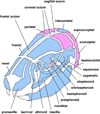Neural crest cell signaling pathways critical to cranial bone development and pathology
- PMID: 24509233
- PMCID: PMC4072849
- DOI: 10.1016/j.yexcr.2014.01.019
Neural crest cell signaling pathways critical to cranial bone development and pathology
Abstract
Neural crest cells appear early during embryogenesis and give rise to many structures in the mature adult. In particular, a specific population of neural crest cells migrates to and populates developing cranial tissues. The ensuing differentiation of these cells via individual complex and often intersecting signaling pathways is indispensible to growth and development of the craniofacial complex. Much research has been devoted to this area of development with particular emphasis on cell signaling events required for physiologic development. Understanding such mechanisms will allow researchers to investigate ways in which they can be exploited in order to treat a multitude of diseases affecting the craniofacial complex. Knowing how these multipotent cells are driven towards distinct fates could, in due course, allow patients to receive regenerative therapies for tissues lost to a variety of pathologies. In order to realize this goal, nucleotide sequencing advances allowing snapshots of entire genomes and exomes are being utilized to identify molecular entities associated with disease states. Once identified, these entities can be validated for biological significance with other methods. A crucial next step is the integration of knowledge gleaned from observations in disease states with normal physiology to generate an explanatory model for craniofacial development. This review seeks to provide a current view of the landscape on cell signaling and fate determination of the neural crest and to provide possible avenues of approach for future research.
Keywords: BMP; Craniofacial anomaly; Development; Hedgehog; Neural crest; Wnt.
Copyright © 2014 Elsevier Inc. All rights reserved.
Figures
References
-
- Fernandez L, Nevado J, Santos F, Heine-Suner D, Martinez-Glez V, Garcia-Minaur S, Palomo R, Delicado A, Pajares IL, Palomares M, Garcia-Guereta L, Valverde E, Hawkins F, Lapunzina P. A deletion and a duplication in distal 22q11.2 deletion syndrome region. Clinical implications and review. BMC Med Genet. 2009;10:48. - PMC - PubMed
-
- Liu KJ. Future directions: molecular approaches provide insights into palatal clefting and repair. Front Oral Biol. 2012;16:147–154. - PubMed
Publication types
MeSH terms
Grants and funding
LinkOut - more resources
Full Text Sources
Other Literature Sources
Medical


